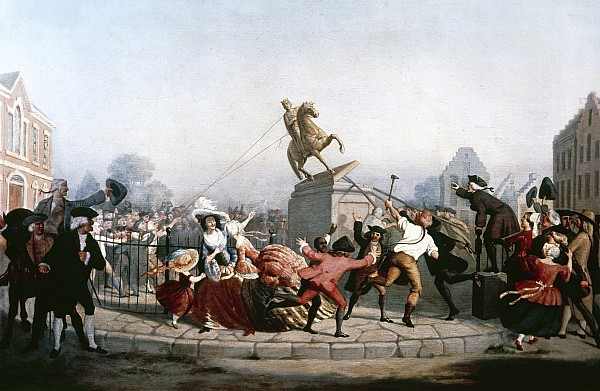When does “finders keepers, losers weepers” not apply?
In 1978, a case concerning a pre-Revolutionary statue of King George III found its way to the Connecticut Supreme Court. According to a 1973 New York Times article, back in 1776 a group of Whigs, upon attending a public reading of the newly signed Declaration of Independence, set about cutting up the royal statue on the Bowling Green of Manhattan. i
Patriots celebrating the signing of the Declaration of Independence demolished the King’s statue where it stood in lower Manhattan. The patriots’ plan was to deliver the statue pieces to Oliver Wolcott’s foundry in Litchfield. There the gilded lead pieces would be made into bullets. En route, the patriot group stopped in Wilton, and while they were busy drinking, loyalists managed to steal back pieces of the statue and scattered them throughout an area known as Davis Swamp.
Some of the pieces were recovered from the Wilton swamp in 1871, and were bought by the New York Historical Society in 1878 for $100. The horse’s tail from the statue was on display at the society’s museum as recently as 2019. ii

In 1972 Louis Miller, armed with information from the Wilton Historical Society, entered onto land owned by Fred S. Favorite. Using a metal detector, Miller found a remaining piece of the statue buried ten inches below the ground. When Favorite sued Miller, who once ran an antiques business, for return of the statue fragment, the trial court focused on the issue of whether the statue piece was property that had been lost, abandoned, or mislaid. The trial court found the piece to be mislaid property and ruled that, under the law, it should be returned to the landowner Favorite.
On appeal, the defendant Miller characterized himself as a “selfless seeker after knowledge” and argued that as a “finder” he was entitled to keep the statue piece. The Connecticut Supreme Court was not persuaded by Miller’s arguments. The Court noted that Miller was not claiming the statue to be “treasure trove” and ruled that Miller’s trespass defeated any claim to the property that he might have had as a finder.
According to the New York Times in 1978, the property owners sold the piece of the statute found on their land to a museum in New York for the amount of $5,500. The Times reported, “The fragment will remain in New York permanently,’ said Walter Marcus, a Norwalk lawyer who represented Fred S. Favorite and other co-owners of the swamp.” iii
See: Favorite v. Miller, 176 Conn. 310 (1978)
i Treasure Hunting: A. Regal Reward – The New York Times (nytimes.com)
ii https://behindthescenes.nyhistory.org/horses-tail-new-york-historical-got-legendary-piece-king-george-iii-statue/
iii 1776 Fragment Put to Final Rest – The New York Times (nytimes.com)
Doses of Connecticut Legal History
SOURCE: CT Judicial Branch
